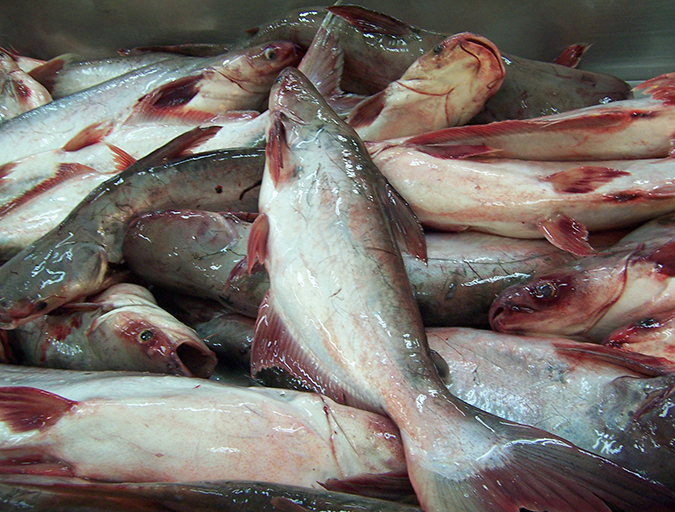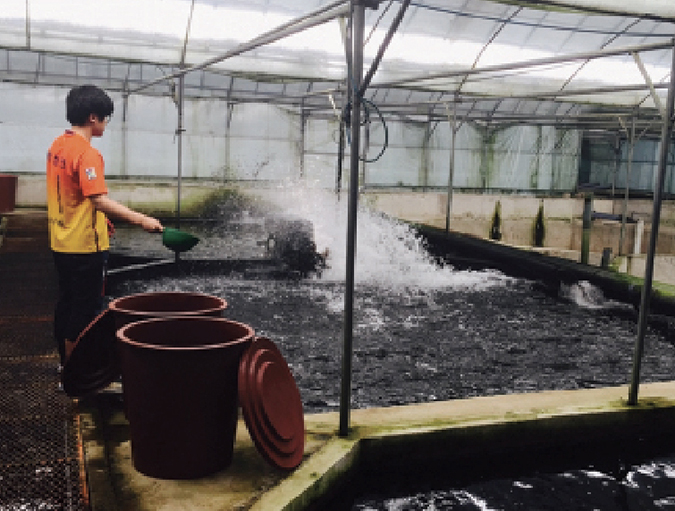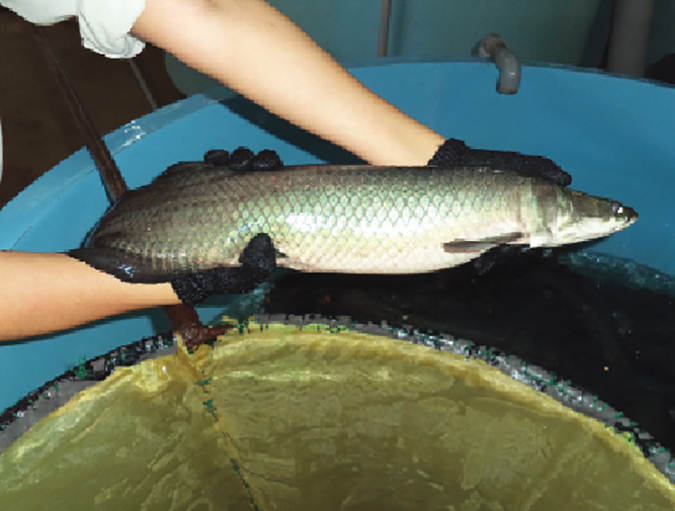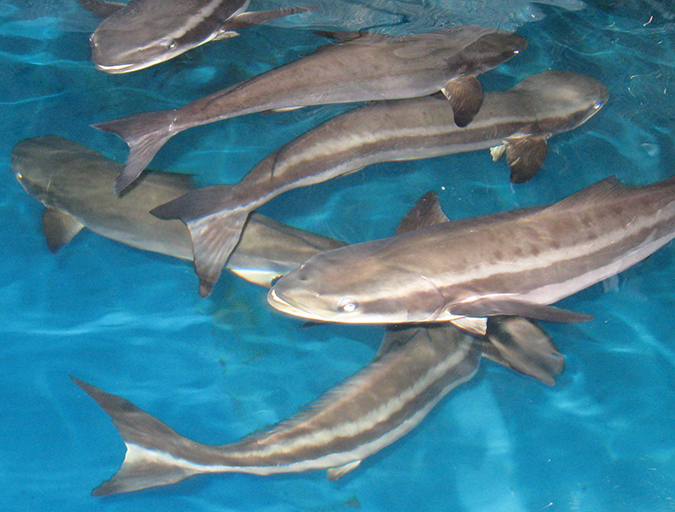Corn distillers dried grains with solubles an excellent source of energy and digestible nutrients

In the quest to find suitable, cost effective, alternative ingredients to use in aquaculture feeds, results from a recent study conducted by the U.S. Grains Council have shown that corn distillers dried grains with solubles (DDGS) is an economical and excellent source of energy and digestible nutrients in pangasius diets.
The aquaculture industry in Vietnam is growing rapidly and the production of Pangasius hypophthalmus, also known as swai or tra — the predominant species of fresh water fish produced in the Mekong River — accounts for more than 1 million metric tons (MMT) produced annually. Vietnam is the third-largest fish exporter in the world, and most of the pangasius produced is exported to many different countries. However, high quality, nutrient dense, economical feed ingredients are needed to reduce cost and enable this rapidly growing industry to remain globally competitive. Corn and corn co-products are economical and excellent dietary energy sources for various aquaculture species, but naturally contain xanthophylls (yellow pigment), which often causes concerns about adding these ingredients at relatively high dietary inclusion rates to diets for some fish species because of the potential “yellowing” of fillets. Achieving a desirable “white” fillet color is essential for meeting consumer preferences and to maintain these important export markets.
DDGS, co-product of ethanol
Corn DDGS is a co-product of ethanol production in the U.S., is produced in large quantities (> 35 MMT), and is used as an economical source of energy, digestible protein and amino acids, and digestible phosphorus in feeds for cattle, swine, poultry, and some aquaculture diets around the world. In 2015, about 12 MMT of DDGS were exported for use in various animal feeds. While the use of DDGS in aquaculture diets has been limited, its use has been increasing rapidly but it is still an unfamiliar feed ingredient for much of the global aquaculture industry. One of the major reasons for the limited use of DDGS until now is that a limited number of research studies have been published to evaluate DDGS use in various aquaculture diets.

Limited information available
However, despite a limited number of published, there is good research evidence indicating that traditional high-oil DDGS can be added to channel catfish (Ictalurus punctatus) diets at dietary levels up to 30 percent. Tidwell et al. (1990) conducted an experiment over an 11-week period where channel catfish fingerlings were fed diets containing 0, 10, 20 and 40 percent DDGS by replacing some of the corn and soybean meal.
After the 11-week feeding period, there were no significant differences in individual fish weight, percentage survival, feed conversion, or protein efficiency ratio (PER) among dietary treatments. Similarly, Webster et al. (1993) conducted a study using cage reared juvenile catfish that were fed diets containing 0, 10, 20, or 30 percent DDGS, which partially replaced corn and soybean meal in the diets. No differences in individual fish weights, survival, feed conversion, carcass composition, carcass waste (head, skin, viscera), and organoleptic properties of the fillets were observed among dietary treatments, indicating that up to 30 percent DDGS can be added to channel catfish diets with no negative effects on growth performance, carcass composition, or flavor qualities of the fillets.

However, subsequent studies conducted by Robinson and Li (2008) and Lim et al. (2009) showed that the addition of crystalline lysine to catfish diets was needed to support optimal growth performance when DDGS was added up to 30 or 40 percent of the diet. In both of these studies, body fat increased when DDGS was added to the diet compared to fish fed the control diets. Most recently, Zhou et al. (2010) replaced soybean meal and corn meals in juvenile hybrid catfish (channel catfish × blue catfish I. furcatus) and observed that diets containing 30 percent DDGS provided good growth, feed conversion, and protein retention.
No studies have been published that have evaluated to effects of adding up to 15 percent DDGS to pangasius diets on growth performance and fillet color. Corn naturally contains xanthophyll pigments, which are concentrated by a factor of 3 times in DDGS, resulting in concentrations of 25 to 50 mg/kg xanthophylls. The bioavailability of xanthophylls in DDGS has not been determined, but common recommendations for the use of corn and corn co-products in American catfish diets indicate that the total diet xanthophyll content should not contain more than 12 mg/kg to achieve acceptable fillet color. As a result, one of the key questions involving DDGS use in pangasius diets is whether this amount of pigment will negatively affect fillet color when 15 percent DDGS diets are is fed to pangasius during a four- to six-month feeding period.

Studies on effect on fillet color
To answer this question, and evaluate the effects of feeding diets containing up to 15 percent DDGS to pangasius on growth performance, the U.S. Grains Council partnered with Pangafeed JSC in Dong Thap Province, Vietnam to conduct a feeding trial. Six thousand pangasius fingerlings (40 g in body weight) were randomly allotted to one of 16 floating cages (300 fish/cage) made of nylon netting located in a 0.5 ha pond that was 3 meters deep on the Hung Vuong Co. experimental farm, Mekong Delta Sadec Province. Four dietary treatments were evaluated over a 118-day feeding period and included 0, 5, 10, or 15 percent DDGS along with soybean meal, rice bran, cassava, fishmeal, wheat and wheat bran (Table 1). The DDGS source used contained 27.7 percent crude protein, 8.9 percent crude fat, 7.7 percent crude fiber, 0.79 percent lysine, 1.1 percent methionine+cysteine, 1.0 percent threonine, and 0.22 percent tryptophan. All diets were formulated to contain the same nutrient content and were manufactured into floating pellets for both the starter (3-4 mm) and grower (5-6 mm) phases.
| Ingredients | 0% DDGS | 5% DDGS | 10% DDGS | 15% DDGS |
|---|---|---|---|---|
| Soybean meal | 487 | 468.2 | 456.2 | 447 |
| Rice bran, full fat | 224.5 | 145.1 | 154.6 | 133.6 |
| Wheat bran | 0 | 0 | 0 | 0 |
| Defatted rice bran | 50 | 100.1 | 50 | 0 |
| Cassava | 120 | 120.1 | 120.1 | 165.1 |
| Wheat | 50 | 50 | 50 | 50 |
| Fishmeal, 62% | 40 | 40 | 40 | 47.5 |
| Fishmeal, 55% | 12 | 12 | 14.5 | 11 |
| DDGS | 0 | 50 | 100 | 150 |
| Premix | 10.5 | 10.5 | 10.5 | 10.5 |
| Ingredients | 0% DDGS | 5% DDGS | 10% DDGS | 15% DDGS |
|---|---|---|---|---|
| Soybean meal | 447 | 428 | 424 | 412 |
| Rice bran, full fat | 233 | 202 | 166 | 125 |
| Wheat bran | 50 | 50 | 50 | 15 |
| Defatted rice bran | 0 | 0 | 0 | 0 |
| Cassava | 120 | 120 | 120 | 120 |
| Wheat | 80 | 80 | 80 | 117.5 |
| Fishmeal, 62% | 30 | 30 | 30 | 30 |
| Fishmeal, 55% | 26 | 26 | 16 | 15 |
| DDGS | 0 | 50 | 100 | 150 |
| Premix | 8 | 8 | 8 | 8 |
At the end of the 118-day feeding period, there were no differences in growth performance among the dietary treatments. Body weights of fish fed 0, 5, 10, and 15 percent DDGS diets were 471, 472, 470, and 490 g, respectively. Feed to gain ratios were 1.59, 1.62, 1.56, and 1.53 for fish fed diets containing 0, 5, 10, and 15 percent DDGS respectively. Mortality of fish was not different among dietary treatments and ranged between 3.7 to 4.9 percent. Fillet yield was slightly improved by feeding the 15 percent DDGS diets (531 g/kg) compared with feeding the control diet containing no DDGS (526 g/kg). Fillet color was evaluated at 3 locations (anterior, middle, and posterior positions) of fillets using L*, a*, and b* in the Hunter Lab colorimetric system. The L* indicates lightness or darkness of color, a* indicates redness of color, and b* indicates yellowness of color. There were no differences in each of the color score measures for fillet color among dietary treatments after feeding them for 118 days.
To evaluate the long-term effects of feeding DDGS diets on fillet color, 50 fish were retained and kept in smaller cages for an additional 66 days, and harvested at 0.9-1.0 kg body weight. There were no differences in L* or b* scores of fillets among dietary treatments, with minor differences in a* between fillets from fish fed the 10 percent DDGS diets compared with the control diets, but not for fish fed 15 percent DDGS diets.
Perspectives
Results from this feeding trial showed that the addition of up to 15 percent DDGS as an energy and protein source, to replace rice bran and partially replace soybean meal in starter and grower pangasius diets, provides excellent growth performance, with no negative effects on mortality, fillet yield or fillet color.
Authors
-
Dr. Jerry Shurson
Department of Animal Science
University of Minnesota
1988 Fitch Ave.
St. Paul, MN USA 55108 -
Dr. Budi Tangendjaja
U.S. Grains Council
Komplek BPT No. 12 RT 1/3
Banjarwangi Ciawi, Bogor 16720 Indonesia
-
Chien Tran Trong
U.S. Grains Council
13/F Hanoi Tower
19 Hai Ba Trunk
Hanoi, Vietnam
-
Le Thi Ngoc Thuy
Hung Vuong Tay Nam Pangafeed JSC
Sa Dec City, Dong Thap Province, Vietnam
Tagged With
Related Posts

Intelligence
Risk v. hazard: A dispassionate look at pangasius
Vietnam’s pangasius industry captivated the global seafood industry, environmental organizations and the mass media. A scientific look at harmful substances detected in exported fillets and the reporting of the associated health risks through the media finds wide disparities.

Aquafeeds
Natural feed additives enhance rainbow trout performance
Various additives, many of plant origin, have been explored to replace the use of antibiotics in aquafeed. The authors compared the performance of rainbow trout fed diets containing oxytetracycline or mineral additives yellow loess and Song-Gang stone powder.

Aquafeeds
Soy-based feeds evaluated for production of Amazonian paiche
A cooperative feeding demonstration conducted by USSEC and Amazon Fish Products S.A. evaluated the use of soy to partially replace fishmeal in diets for paiche, or pirarucu, the largest freshwater fish species.

Intelligence
Global Farmed Finfish Production Outlook: Slower-paced growth
The GOAL 2016 survey for global production of farmed fish shows that most major finfish groups increased their farmed production in 2015. The total production of species and countries covered by the survey is forecasted to reach 42 MMT in 2016.


